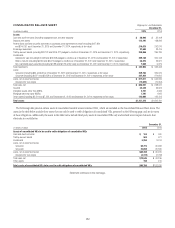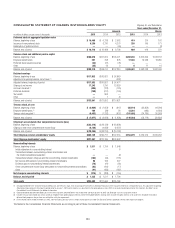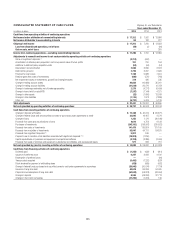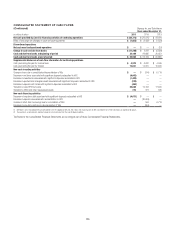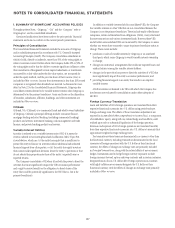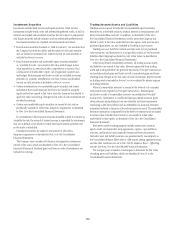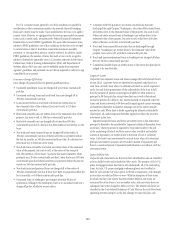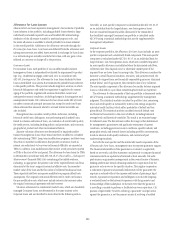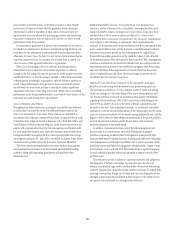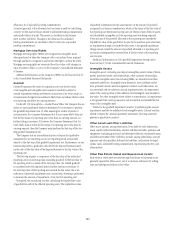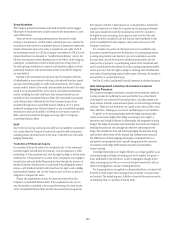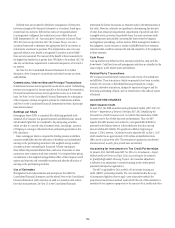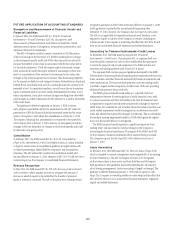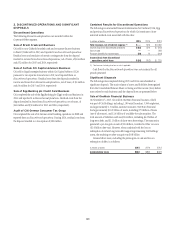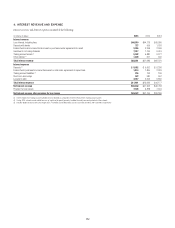Citibank 2015 Annual Report Download - page 160
Download and view the complete annual report
Please find page 160 of the 2015 Citibank annual report below. You can navigate through the pages in the report by either clicking on the pages listed below, or by using the keyword search tool below to find specific information within the annual report.142
loan situation and rarely occurs. If Citi does not pursue a legal remedy,
it is because Citi does not believe that the guarantor has the financial
wherewithal to perform regardless of legal action or because there are
legal limitations on simultaneously pursuing guarantors and foreclosure.
A guarantor’s reputation does not impact Citi’s decision or ability to seek
performance under the guarantee.
In cases where a guarantee is a factor in the assessment of loan losses, it
is included via adjustment to the loan’s internal risk rating, which in turn
is the basis for the adjustment to the statistically based component of the
Allowance for loan losses. To date, it is only in rare circumstances that an
impaired commercial loan or commercial real estate loan is carried at a
value in excess of the appraised value due to a guarantee.
When Citi’s monitoring of the loan indicates that the guarantor’s
wherewithal to pay is uncertain or has deteriorated, there is either no
change in the risk rating, because the guarantor’s credit support was never
initially factored in, or the risk rating is adjusted to reflect that uncertainty
or deterioration. Accordingly, a guarantor’s ultimate failure to perform or
a lack of legal enforcement of the guarantee does not materially impact
the allowance for loan losses, as there is typically no further significant
adjustment of the loan’s risk rating at that time. Where Citi is not seeking
performance under the guarantee contract, it provides for loan losses as if the
loans were non-performing and not guaranteed.
Reserve Estimates and Policies
Management provides reserves for an estimate of probable losses inherent
in the funded loan portfolio on the Consolidated Balance Sheet in the
form of an allowance for loan losses. These reserves are established in
accordance with Citigroup’s credit reserve policies, as approved by the Audit
Committee of the Citigroup Board of Directors. Citi’s Chief Risk Officer and
Chief Financial Officer review the adequacy of the credit loss reserves each
quarter with representatives from the risk management and finance staffs
for each applicable business area. Applicable business areas include those
having classifiably managed portfolios, where internal credit-risk ratings
are assigned (primarily ICG and GCB) or modified Consumer loans, where
concessions were granted due to the borrowers’ financial difficulties.
The above-mentioned representatives for these business areas present
recommended reserve balances for their funded and unfunded lending
portfolios along with supporting quantitative and qualitative data
discussed below:
Estimated probable losses for non-performing, non-homogeneous
exposures within a business line’s classifiably managed portfolio and
impaired smaller-balance homogeneous loans whose terms have been
modified due to the borrowers’ financial difficulties, where it was
determined that a concession was granted to the borrower. Consideration
may be given to the following, as appropriate, when determining this
estimate: (i) the present value of expected future cash flows discounted at the
loan’s original effective rate; (ii) the borrower’s overall financial condition,
resources and payment record; and (iii) the prospects for support from
financially responsible guarantors or the realizable value of any collateral.
In the determination of the allowance for loan losses for TDRs, management
considers a combination of historical re-default rates, the current economic
environment and the nature of the modification program when forecasting
expected cash flows. When impairment is measured based on the present
value of expected future cash flows, the entire change in present value is
recorded in the Provision for loan losses.
Statistically calculated losses inherent in the classifiably managed
portfolio for performing and de minimis non-performing exposures.
The calculation is based on: (i) Citi’s internal system of credit-risk ratings,
which are analogous to the risk ratings of the major rating agencies; and
(ii) historical default and loss data, including rating agency information
regarding default rates from 1983 to 2014 and internal data dating to the
early 1970s on severity of losses in the event of default. Adjustments may
be made to this data. Such adjustments include: (i) statistically calculated
estimates to cover the historical fluctuation of the default rates over the credit
cycle, the historical variability of loss severity among defaulted loans, and the
degree to which there are large obligor concentrations in the global portfolio;
and (ii) adjustments made for specific known items, such as current
environmental factors and credit trends.
In addition, representatives from each of the risk management and
finance staffs that cover business areas with delinquency-managed
portfolios containing smaller-balance homogeneous loans present their
recommended reserve balances based on leading credit indicators, including
loan delinquencies and changes in portfolio size as well as economic trends,
including current and future housing prices, unemployment, length of time
in foreclosure, costs to sell and GDP. This methodology is applied separately
for each individual product within each geographic region in which these
portfolios exist.
This evaluation process is subject to numerous estimates and judgments.
The frequency of default, risk ratings, loss recovery rates, the size and
diversity of individual large credits, and the ability of borrowers with foreign
currency obligations to obtain the foreign currency necessary for orderly debt
servicing, among other things, are all taken into account during this review.
Changes in these estimates could have a direct impact on the credit costs in
any period and could result in a change in the allowance.


